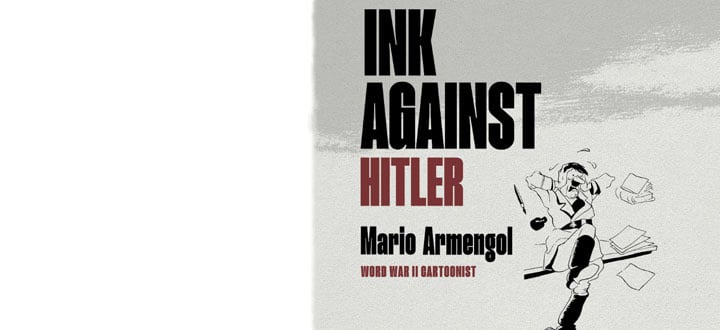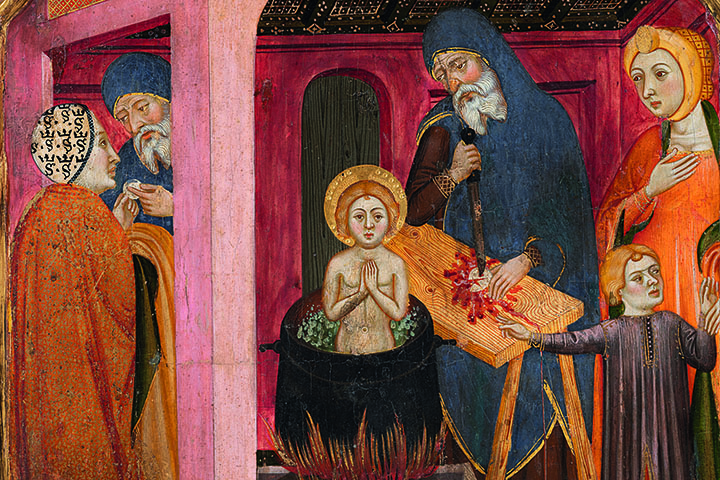Commented works: Anti-Judaism And Mediatic Images
21 - Guillem Seguer (?) (act. in Catalonia)
Altarpiece of Corpus Christi from Vallbona de les Monges (Lérida)
c. 1335-45. Tempera and gold leaf on panel
Four of the scenes depicted on the two panels displayed opposite each other here tell of the aggressions (involving a dagger, spear and cauldron) inflicted on the host by some Jews. In another we see a pair of them being burnt at the stake, and a further two in the upper right area of the frontal show a Jew taking communion and being baptised. Whereas in the episodes of the Eucharistic miracles the Jews are portrayed in a clearly negative light, their role is reversed in the latter.
Museu Nacional d’Art de Catalunya, Barcelona
22 - Llorenç Saragossà (?) (act. in Catalonia and Valencia)
Altarpiece of the Eucharist
c. 1370-80. Tempera on panel
Here the glorification of the cult of the Eucharist draws on the affaire des Billettes, a well-known Eucharistic miracle that reportedly occurred in the late 1200s. As illustrated in the lower scenes flanking the Last Supper, a Jew of Paris is given a host by a Christian woman who wishes to retrieve a pawned dress. Accompanied by other members of his faith, the Jew subjects the host to different tortures. However, it not only remains intact but also bleeds, clearly evidencing Christ's real presence.
IGLESIA PARROQUIAL DE LA NATIVIDAD DE NUESTRA SEÑORA, DIÓCESIS DE SEGORBE-CASTELLÓN, VILLAHERMOSA DEL RÍO (CASTELLÓN)
23 - Guillem Seguer (?) (act. in Catalonia)
Altar Frontal of Corpus Christi from Vallbona de les Monges (Lérida)
c. 1335–45. Tempera and gold leaf on panel
The two panels displayed here opposite one other were originally the altar frontal and altarpiece of a chapel dedicated to the Corpus Christi in 1348. Like other female communities, the Cistercian nuns of Vallbona made worship of the body of Christ and contemplation of the host the focus of their meditations. This explains the central images of both works and the large cycle of Eucharistic miracles, notably those involving Jews.
Museu Nacional d’Art de Catalunya, Barcelona
24 - Pere Serra (act. in Catalonia and Aragon)
Christ before Pilate
c.1375–1400. Tempera on panel
The figure of Pilate is judged variously. A long tradition dating back to Matthew the Evangelist exonerates him from responsibility for Jesus’ death and pins all the blame on the Jews, as in this panel. Here the Roman prefect seems to hesitate at the Jews’ accusations. In contrast, in other contemporary depictions—such as the painting on view by Alonso Sedano—Pilate takes part wholeheartedly together with the other Jews in the conviction and death of the Messiah.
Museu Episcopal de Vic
25 - Alonso de Sedano (act. in Castile)
Eccehomo
c. 1495–96. Oil on panel
The Jews clamouring for Christ’s execution are characterised by their exaggerated gestures, discriminatory clothing and distorted faces. Pilate, appearing on the right, gives the go-ahead on Caiaphas’s advice. The dramatic and theatrical tone of the painting displays many parallels with contemporary accounts of the Passion, many of them composed in verse and in vernacular languages, such as the well-known Pasión trobada by Diego de San Pedro (c. 1470–80).
Museo Diocesano de la Catedral de Burgos
26 - Christ before Pilate and Flagellation of Christ in the Catalan Passion
c. 1340. Illuminated parchment
This manuscript seeks to convey in images the major role played by the Jews in the Passion. Whereas in the scene of Christ before Pilate the characters accusing the Messiah are labelled as ‘Jews’, there is a further turn of the screw in the Flagellation scene, where not only are the two executioners portrayed as Jews but the inscriptions brand them as ‘evil’. The Catalan text states that it was designed for a lay audience.
Bibliothèque nationale de France, París
27 - Joan Reixach (act. in Valencia)
Predella with Passion scenes
c. 1454. Tempera and oil on panel
In this sequence of episodes of the Passion from the altarpiece of the Charterhouse of Valldecrist (Castellón), many of the Romans and Jews wear Arab-style clothing. Pilate sports a headdress similar to that of Caiaphas, a Jewish priest. The anachronistic association of the gospel figures of the Passion with Muslims—also considered enemies of the Christian faith—was relatively common in Spanish Gothic art and was a new means of visual stigmatisation. The exception is Judas, who is based on the usual defamatory stereotype.
Museu de Belles Arts de València
28 - Passion Scenes, in Speculum animae
c. 1500. Coloured inks on paper
The kingdoms of Iberia have bequeathed a rich collection of representations of the Passion that stress Jewish culpability. A particularly significant, extensive and vitriolic example is the Speculum Animae. In this manuscript a series of torture episodes from apocryphal sources is added to the cycle of traditional images of the Passion. One shows the punishments inflicted on Christ on crossing the Kidron stream. The purpose seems clear: to move the recipients of the codex, the nuns of the convent of La Trinidad in Valencia.
Bibliothèque nationale de France, París
29 - Jaume Serra (act. in Catalonia and Aragon)
Last Supper
c. 1360–70. Tempera and gold leaf on panel
In the Last Supper scene of the Villahermosa del Río altarpiece, the Sijena predella and this small painting, the figure of Judas is characterised with physiognomic features (reddish hair, hooked nose, exaggerated profile) and clothing (yellow) that signal his evil nature—in the Sijena panel he is even accompanied by the devil. He is the counterfigure of the Christian, the result of an exercise in visual otherness that was also used to debase Jews. From Judas to the Jews.
Galleria Regionale della Sicilia, Palazzo Abatellis, Palerm
30 - Jaume Serra (act. in Catalonia and Aragon)
Predella of the Altarpiece of the Virgin in the monastery of Santa María de Sijena
(Huesca)
c. 1367–81. Tempera and gold leaf on panel
In this predella the Eucharistic miracle of Billettes (Paris) is summed up in a single compartment to the right of the Last Supper. It features a variant: in the cauldron—an allusion to desecration in boiling water—the host turns into the Christ Child. The Paris story was widely publicised and depicted in multiple versions during the Late Middle Ages—so many that it played a decisive part in spreading the libel of Jews as desecrators of Blessed Sacraments. Images were a key driver of anti-Judaism.
Museu Nacional d’Art de Catalunya, Barcelona/p>
31 - Caricatures
Christian notarial books known as "Libri Iudeorum" record financial transactions of the Jews in Catalonia, especially their loans. Many of these books include cartoons of Jews who reproduce a stereotype repeated since the 13th century, determined by facial features exaggerated such as the excessive nose and eyes or the unkempt beard. The iconographic resource is based in ideas of the ancient world that equated physical diversity with the exotic and the monstrous. It It is true that physiognomic deformations must be interpreted as a way of expressing a alleged moral inferiority and they give life to strange, even threatening, individuals. Ultimately, this builds the paradigm of the other".
32 - Caricature of Salomó Vidal in a liber iudeorum
c. 1334–40. Ink on parchment
This book recorded the loans granted by Salomó Vidal in Vic from 1334 to 1340. He is depicted with a fantastical headdress and monstruous face with a huge nose, a gaping mouth and a squint. The informality of the drawing indicates that it is the spontaneous product of a Christian notary with limited artistic training who vented all his resentment of a well-known, powerful Jewish moneylender in it.
Arxiu i Biblioteca Episcopal de Vic
33 - Jew-bearing demon on a liber iudeorum
15th century. Ink on parchment
The vitriolic depiction of three Jews being carried off by a grinning black devil suggests the profound hostility aroused by the money-lending business of some members of this community. The Church’s prohibition against Christians lending at interest to other believers led the authorities to encourage Jews into the money trade to keep capital flowing. This gave rise to some of the most widespread denigratory anti-Jewish clichés.
Biblioteca de Catalunya, Barcelona










